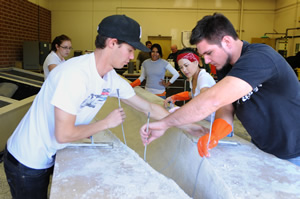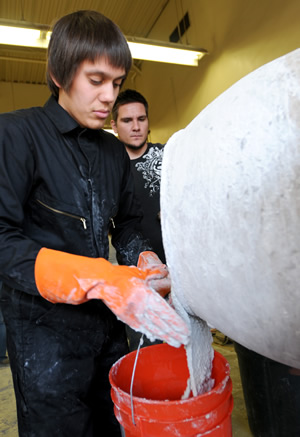Float Like a Stone
Student-Built Concrete Canoe to Race in Hawaii
Results Update
This time Goliath won.
Cal State Fullerton's engineering team garnered praise from other teams, but placed 16th overall in the three-day competition at the Pacific South West Regional Conference of the American Society of Civil Engineers April 1-4. in Hawaii. The Titans placed just above UC Irvine's team, which ranked last in the standings.
A little David, compared to the Goliath-sized programs fielded by the competition, the Cal State Fullerton canoe-racing and bridge-building team had 17 members. The next smallest team had 30, and the overall winner, Cal Poly San Luis Obispo, had the largest team, at 80.
“We were exhausted,” said Cal State Fullerton canoe team leader Andrew Atry, a senior, who was both exhilarated by the attention and disappointed by the outcome at the same time. “All of us were pulling double and triple duty.”
As a racing vessel and teaching tool, the 22-foot-long, 275-pound concrete canoe leads a double life.
As a racing vessel, it is now on its way to Waikiki where it will compete with 16 others in the University of Hawaii-hosted American Society of Civil Engineers Pacific South West Regional Conference April 1-4.
As a teaching tool, it’s design, manufacture and successful transport to Hawaii have been the central preoccupation of 11 Cal State Fullerton engineering students for the last 11 months.
Binod Tiwari, assistant professor of civil and environmental engineering and the adviser to the team of civil and environmental engineering students who designed and built the canoe, calls it an intense experience in design, materials and structural engineering.
It is a fun project for the students, but it’s also a yearlong learning experience from end-to-end that starts immediately after the contest ends the previous year.
“It all starts with Archimedes Principle of displacement,” which determines whether something is buoyant or will sink, said team co-captain Andrew Atry, a senior civil and environmental engineering student. “First, we have to make a concrete that floats. We’ve done that. Then, it has to hold together. We’re sure we’ve figured that out, too. The rest is design and materials.”

From left, sophomore Marcelo Guzman; junior Karen Nguyen, who is one of the paddlers; and senior Andrew Atry, project coordinator, prepare the canoe for another layer of concrete in Room 10 of the Engineering Building, where the vessel was built. Photo by Kelly Lacefield
Canoe team members have spent several hours a week designing and testing, meanwhile squeezing in time to raise funds to pay for the project. Shipping the canoe to Hawaii alone has a $3,000 price tag. However, when the savvy students saw the size of the container that could be shipped for that price, they cut their tab by allowing the Cal State Long Beach team to ship their canoe in the excess space.
Each competing canoe must carry four paddlers and be maneuverable enough to negotiate a u-turn at the halfway mark and sprint back.
Winning the race is only the half of it.
Literally.
Half the points in the competition are based on material samples, papers and presentations read at the conference. Brawn and brains both count.

Anthony Hangartner, left, a senior and lead team member in the development of the concrete, gathers concrete for the canoe with the help of Andrew Atry, a senior and the project's coordinator. Photo by Kelly Lacefield
Consider this, Tiwari said:
- Student engineers must reconcile the requirements of strength, size and maneuverability. Team members study winning canoes from years past and employ computer modeling.
- Students must devise a customized concrete mix that will mold easily to the form, cure without cracking, stand up to the rigors of shipping and float. Where ordinary concrete would have sand, ASCE students grind up specially formulated fiberglass. The engineering majors found they could add considerable strength by reinforcing the canoe with carbon fiber and steel-wire mesh between concrete layers.
- Students must take exacting care in packing if their 22-foot canoe of thin, inflexible material is to survive the rigors of shipping. The crate constitutes a second materials and structural engineering problem, and students keep their design solutions secret so competitors can’t steal their ideas.
“We hope to do very well this year, and we feel we have reason to be optimistic,” Tiwari said. “We’ve competed for a few years, and were always somewhere near the bottom. Then last year we moved up considerably, finishing fifth overall.
“This year, we were able to upgrade our materials and we have a great group of students, some of whom have been through this before and learned from it. The students before this were very competent, so much of the difference was the opportunity to purchase lighter, stronger materials, like the kind of carbon fiber and steel-wire mesh being used this year.”
Senior civil and environmental engineering student Rosa Aleman is on her second year with the canoe, and will be a paddler. She, too, is optimistic.
“We’re really learning applied engineering from this canoe competition, using what we were taught in classes. This year, there are some differences. We’re using this concrete mixer,” she said, gesturing across Room 10 of the Engineering Building and raising her voice to be heard above the noisemaker. “A mixer like that helps even out the composition of the concrete and fiberglass.”
Aleman wanted to be an engineer since high school and plans to pursue a doctorate, specializing in structures.
Tiwari said there is a connection between building a concrete canoe and structures. “Different products come out of competitions like this, new procedures and approaches
“For example,” said Tiwari, an expert in soils, landslides and earthquakes, “lighter buildings tolerate earthquake shaking better than heavy buildings, so light-but-strong concrete, such as they have developed could one day make buildings more earthquake safe.”
Senior civil and environmental engineering major Scott Johnson, co-captain with Atry, said he wants to go to Alabama in May. “That’s where the nationals will be held. The winner of this race gets to compete against the other ASCE winners at the May conference.”
Media Contacts:
Binod Tiwari, Civil and Environmental Engineering, 657-278-3968 or btiwari@fullerton.edu
Russ L. Hudson, Public Affairs, 657-278-4007 or rhudson@fullerton.edu
